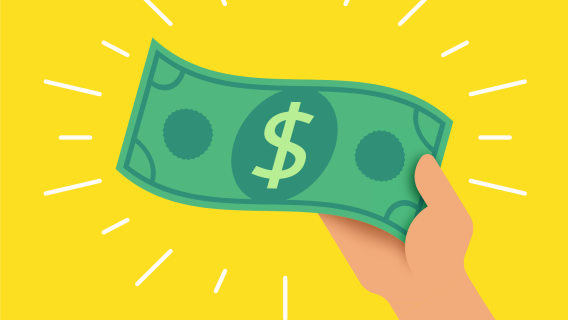On Wednesday, the Fed made a widely expected 0.25% cut to the fed funds rate, but at the same time, inflation is running somewhere around 2.9%, depending on which data points you are looking at.
That means the yields on your cash are falling (and expected to fall further) while inflation erodes your purchasing power.
Even if you’re getting a yield north of 4% on your cash, that translates to only a 1.1% return when adjusted for inflation.
And that’s assuming you’ve opened a halfway-decent high-yield savings account; your local bank probably isn’t offering anything close to that on a traditional savings account.
However, there are two strategies any investor can use to create yield that far exceeds traditional avenues. These options strategies are covered calls and writing puts, and both can help you beat inflation. Keep in mind, both of these options strategies are inherently bullish, so your outlook for the stocks should be as well.
Covered Calls
Many years ago, my grandfather owned a couple of Exxon Mobil (XOM) gas stations in downtown Chicago. He loved the company, and over the years, he accumulated a couple of thousand shares of XOM. Upon his passing, each of his grandchildren received 200 shares. The options trader in me immediately went to work managing my newfound position, and I started selling covered calls.
[text_ad]
A covered call is a strategy that consists of owning an underlying stock and selling an option against the stock. Since a call option represents 100 shares of the underlying stock, you can sell one call against each 100 shares of stock you own. Because you own the stock, your short call position is “covered” by the stock.
A short option position by itself (without the stock) is very risky and requires a substantial margin balance. A short call on stock you own, on the other hand, is a very conservative strategy that requires no margin.
I would recommend a covered call options strategy against virtually any stock an investor holds. In my mind, it’s free money.
Let’s dive a bit deeper into this strategy.
Today XOM is trading at 114, and as an owner of 200 shares, I can sell two calls against my stock position to create extra yield.
Here is the call I might sell:
Sell to Open 2 XOM December 120 Calls (exp. 12/19) for $2.40.
If XOM stays below 120 by December expiration, I would have collected $480 total ($240 for each contract x 2)—a yield of 2.1% in just three months.
If XOM rises above 120, I would have made $1,200 (120 strike price minus the current price of 114 x 2 contracts) on my stock, plus I would have banked my call premium, but been taken out of my 200 shares by the owner of the call. However, if that were to happen, I could simply buy my stock back if I wanted to, and start selling calls all over again.
Writing Put Options
Writing puts is a more complex strategy, but when broken down and understood, this can be a tremendous trading strategy and a great way to create yield for all investors.
Let’s start with what a put is. A put is a contract between two parties to exchange an underlying stock, at a specific price, on a determined date. The buyer of the put has the right to sell the underlying stock at a set price. The seller of the put has the obligation to buy the underlying stock at the set price.
If you write a put, you are the seller of the put. This can be thought of in terms of insurance: you’re the insurance agency, and the buyer of the put is the policy owner. If the owner of the put decides to exercise his right, you will be required to buy the stock at the predetermined price. However, as the seller of the put (the insurance agency), you receive a premium.
Let’s look at an example of this strategy:
Today, Apple (AAPL) is trading at 238. If I feel comfortable buying 100 shares of AAPL stock at 220, I might look to execute this trade:
Sell to Open 1 AAPL December 220 Put for $4.50.
If Apple’s stock price stays above 220 on December 19 (when the options expire), I would collect the $450 premium I received for selling the put, a yield of 2%.
There is risk associated with this trade: if AAPL drops below 220, I would be required to buy AAPL shares at 220. But as I said earlier in the hypothetical, I was comfortable buying AAPL at 220, which is a 7.6% discount to where the stock is trading now.
This is a strategy many traders/investors use to enter a stock at a predetermined price. If I felt that AAPL was overvalued at its current price of 238, but I was comfortable buying the stock at 220, this is a great way to buy the stock at that level if the price drops. And if it didn’t, I’d still have collected the premium and could always have sold another put later on.
In conclusion, there are countless ways to use options to create portfolio yield, and covered calls and put writing should be in every investor’s playbook.
[author_ad]
*This post has been updated from a previously published version.

